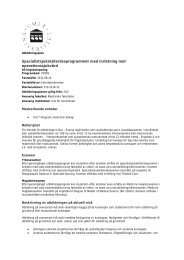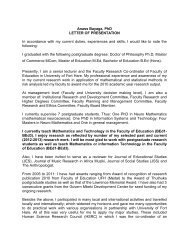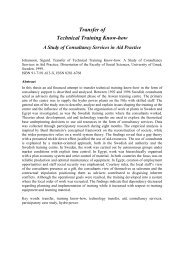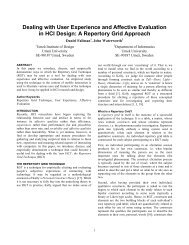Organisational Structure as Barrier or Support in the Personal Social ...
Organisational Structure as Barrier or Support in the Personal Social ...
Organisational Structure as Barrier or Support in the Personal Social ...
Create successful ePaper yourself
Turn your PDF publications into a flip-book with our unique Google optimized e-Paper software.
Table: 9. H<strong>as</strong> <strong>the</strong> number of social w<strong>or</strong>kers you have been see<strong>in</strong>g l<strong>as</strong>t year been imp<strong>or</strong>tant toyou? (Percentage of all respondents)***Integrated Comb<strong>in</strong>ed SpecialisedYes, very much imp<strong>or</strong>tant 23,9 13,6 19,6Yes, pretty much9,0 8,5 19,6imp<strong>or</strong>tantPartly imp<strong>or</strong>tant 7,5 20,3 23,2No, hardly not imp<strong>or</strong>tant 13,4 27,1 5,4No, not imp<strong>or</strong>tant at all 34,3 16,9 23,2I do not know 11,2 13,6 8,9n= 67 59 56Significance: ***=0,01, **=0,05, *=0,10Table: 10. How many social w<strong>or</strong>kers would you like to have contact with, regard<strong>in</strong>g help andsupp<strong>or</strong>t to you? (Percentage of all respondents)Integrated Comb<strong>in</strong>ed SpecialisedIt does not matter 10,4 22,8 12,1I do not know 9,0 8,8 13,81 social w<strong>or</strong>ker 64,2 52,6 56,92 social w<strong>or</strong>kers 16,4 15,8 15,53 social w<strong>or</strong>kers 0 0 1,7n= 67 57 58As we understand it, a lot of clients (between 41 and 62 percent) th<strong>in</strong>k that <strong>the</strong> number ofsocial w<strong>or</strong>kers <strong>the</strong>y have contact with is imp<strong>or</strong>tant, even if quite many clients (29 to 48percent) answers that it does not matter. The answers on <strong>the</strong> question about how many socialw<strong>or</strong>kers <strong>the</strong> clients want to have contact with clearly show that a maj<strong>or</strong>ity (between 68 and 81percent) prefer to have contact with only one <strong>or</strong> two social w<strong>or</strong>kers, irrespective of type of<strong>or</strong>ganisation. Why most clients prefer one <strong>or</strong> two social w<strong>or</strong>kers is elucidated by answers on afollow-up question where (n=119) clients with <strong>the</strong>ir own w<strong>or</strong>ds described <strong>in</strong> which way <strong>the</strong>number of social w<strong>or</strong>kers had imp<strong>or</strong>tance. Below are a number of significant examples:- It h<strong>as</strong> been good to meet one and <strong>the</strong> same, because this person h<strong>as</strong> <strong>the</strong> situation undercontrol each time we meet.- It is better with 1-2 persons, because if <strong>the</strong>re are m<strong>or</strong>e people it feels like ones problemwon’t be taken seriously. I want to confide myself to so few people <strong>as</strong> possible. O<strong>the</strong>rwise Icould write a book with <strong>the</strong> title “Here is my problem”.- I have trouble with human relations and to trust people, so <strong>the</strong> smaller number of socialw<strong>or</strong>kers <strong>the</strong> better. It is positive that I have <strong>the</strong> same person that helps me with everyth<strong>in</strong>g.- It h<strong>as</strong> been quite hard to change social w<strong>or</strong>ker often; it feels like you have to start all overaga<strong>in</strong>.- Everyth<strong>in</strong>g gets messy, nobody knows me. You have to take <strong>the</strong> same st<strong>or</strong>y f<strong>or</strong> everyoneseveral times, but no one understands.16
















